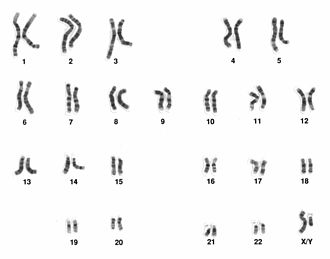Karyotype
Karyotype is a profile of organisms chromosomes which are organized by their size, pattern and location of centromere. The order of chromosomes is done according to the size as it´s easier for specialists to find some disorders.
Humans has 22 pairs of autosomal chromosomes (numbered 1 to 22) and 1 pair of sex chromosomes (X, Y). The common samples are blood cells, bone marrow cells or amniotic fluid (prenatal diagnosis). The whole test of karyotype takes 1-3 weeks (depending on the material used) and it is done in a cytogenetics laboratory.
Normal human DNA is a very long string. When we want to see chromosomes as we are used to see, we have to examine them in their most compact shape. This form is typical for one phase of mitosis – metaphase. We can stop the growth by using some special chemicals (like colchicine or its synthetic derivates). Also the typical striped pattern is caused by chemicals – e.g. by Giemsa dye – which stains adenine and thymine bases.
How Do We Test Karyotype?[edit | edit source]
- Collecting of the samples – the most common are blood cells (especially the white ones - they are actively dividing).
- Growing of the cells – it is necessary to cultivate the cells on the right medium or cell culture.
- Stoping of the growth – we have to stop division in metaphase.
- Dying of chromosomes – chromosomes are normally colorless so we use various staining and banding methods for visualization.
- Sorting of chromosome – from the largest (chromosome 1) to the smallest (chromosome 22).
- Analysing – structure, pattern, count.
Links[edit | edit source]
Related articles[edit | edit source]
External links[edit | edit source]
Bibliography[edit | edit source]
- ALBERTS,, et al. Základy buněčné biologie. 2.vydání edition. 1998. ISBN 80-902906-2-0.

